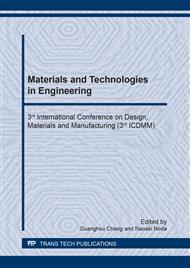p.3
p.8
p.15
p.23
p.28
p.35
p.40
p.46
Evaluation of Mechanical Properties of Dimpled PET Fiber Fabricated by Electrospinning Method
Abstract:
Insufficient endothelialization of stent grafts tends to cause a problem of thrombosis formation. Because the structure of nanofibers, generally defined as fibers with a diameter below 1 μm, resembles the structure of an extracellular matrix, nanofibers are applied to scaffolds for regenerative medicine. Using nanofibers as the covering material of the stent graft can be expected to solve the problem of the stent graft. Previous studies have shown that a porous scaffold offers better surfaces to anchor and culture endothelial cells than a nonporous scaffold. Therefore, fibers with nanoorder dimples are expected to promote endothelialization. As a method of forming the dimple shape on the surface of the PET fiber, there is a method utilizing a difference in the volatilization rate of the solvent in the high humidity environment in the electrospinning method. For practical application of the stent graft to artificial blood vessels, the mechanical properties of the dimpled PET fiber should be clarified. In this study, the mechanical properties of single nanofibers and nonwoven fabrics of PET fibers with dimples on their surface were evaluated by tensile test. By forming the dimple shape on the fiber surface, the tensile strength of single PET fibers with dimples was 90 % lower than that of single PET fibers with a smooth surface. In the fabrication process of nonwoven fabric, the addition of EG delayed the volatilization of the PET solution, and the fibers adhered to each other. The bonding between the fibers contributed to the tensile strength of the nonwoven fabric.
Info:
Periodical:
Pages:
8-14
Citation:
Online since:
December 2018
Authors:
Keywords:
Price:
Сopyright:
© 2018 Trans Tech Publications Ltd. All Rights Reserved
Share:
Citation:


